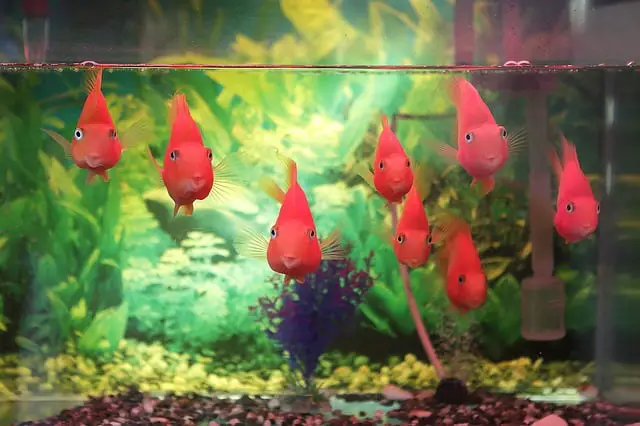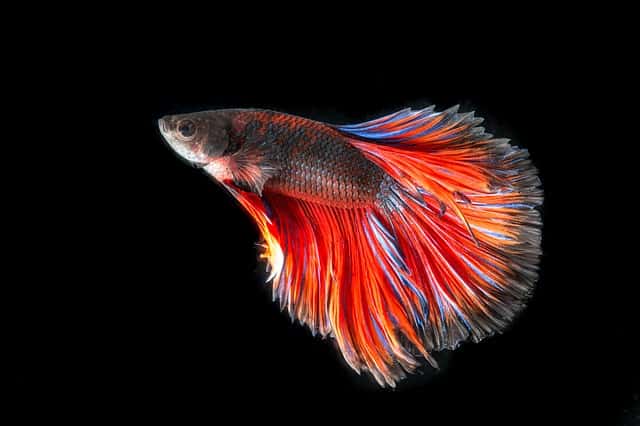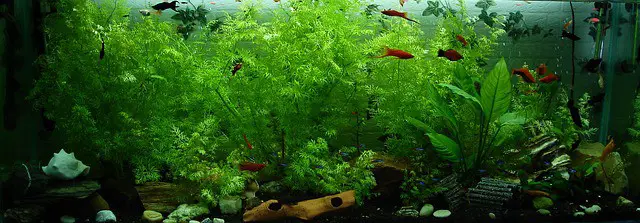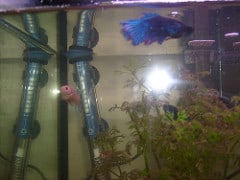In the world of home decor and aquatic hobbies, corner fish tanks have been gaining popularity as a unique and captivating choice for both beginners and experienced fish enthusiasts. These unconventional aquariums not only add a touch of elegance to your living space but also offer a variety of practical benefits.
In this article, we will explore the fascinating world of corner fish tanks, their advantages, maintenance tips, and more.
Understanding Corner Fish Tanks
Corner fish tanks, as the name implies, are specially designed to utilize the often overlooked corner spaces within a room. Unlike traditional rectangular aquariums that may occupy more central areas, corner tanks offer a unique solution for maximizing space efficiency and aesthetic appeal simultaneously.
Their distinctive triangular or pentagonal shape allows them to seamlessly blend into corners, adding a touch of elegance and sophistication to any environment.
These tanks are available in a variety of sizes and shapes, catering to different preferences and spatial constraints. Whether you have a small nook in your living room or a spacious corner in your office, there’s a corner fish tank to suit your needs.
From compact models perfect for cozy apartments to larger setups that make a statement in grand spaces, the versatility of corner tanks ensures there’s an option for every space and style.
The defining characteristic of corner fish tanks is their unconventional shape, which sets them apart from traditional rectangular aquariums. This unique design not only enhances the visual appeal of the tank but also offers practical benefits.
The angular silhouette creates interesting viewing angles, allowing observers to enjoy panoramic views of the underwater world from multiple perspectives.
The corner placement helps distribute the weight of the tank more evenly, making it an ideal choice for rooms with limited floor space or uneven surfaces.
Beyond their aesthetic appeal, corner fish tanks also provide functional advantages. Their triangular or pentagonal shape allows for better water circulation and flow compared to rectangular tanks, promoting healthier aquatic environments. The design also facilitates natural behaviors and territories for fish, as the curved edges mimic the contours of their natural habitats. Moreover, the corner placement minimizes the visual footprint of the tank, making it feel less obtrusive in the room while still commanding attention as a focal point.
In summary, corner fish tanks offer a blend of form and function that makes them a unique and compelling choice for aquarium enthusiasts. Their space-efficient design, versatile options, and captivating aesthetics make them a welcome addition to any home or office setting.
If you’re a beginner exploring the world of fishkeeping or a seasoned hobbyist looking to elevate your aquatic display, a corner fish tank provides endless possibilities for creating a stunning underwater oasis in the corner of your room.
Advantages of Choosing a Corner Fish Tank
Space Utilization
Corner fish tanks excel in maximizing space utilization within a room, making them an ideal choice for both small and large living spaces alike. By fitting snugly into a corner, these tanks effectively utilize often-underutilized areas, freeing up valuable floor space for other furniture or activities.
This space-saving design is particularly advantageous for apartments, dorm rooms, or offices where every square foot counts. Additionally, the corner placement helps to create a more open and spacious feel in the room, enhancing its overall functionality and aesthetics.
Aesthetic Appeal
One of the most striking advantages of corner fish tanks is their unparalleled aesthetic appeal. Their unique placement in the corner of a room immediately draws the eye and becomes a captivating focal point. With their elegant curves and sleek lines, corner tanks add a touch of sophistication and tranquility to any space, transforming it into a serene aquatic oasis.
Whether adorned with vibrant aquatic plants, colorful fish, or intricate decor, these tanks have the potential to elevate the ambiance of a room and reflect the personal style of the owner.
From modern minimalist designs to ornate and elaborate setups, the versatility of corner fish tanks ensures there’s an option to suit every taste and interior decor theme.
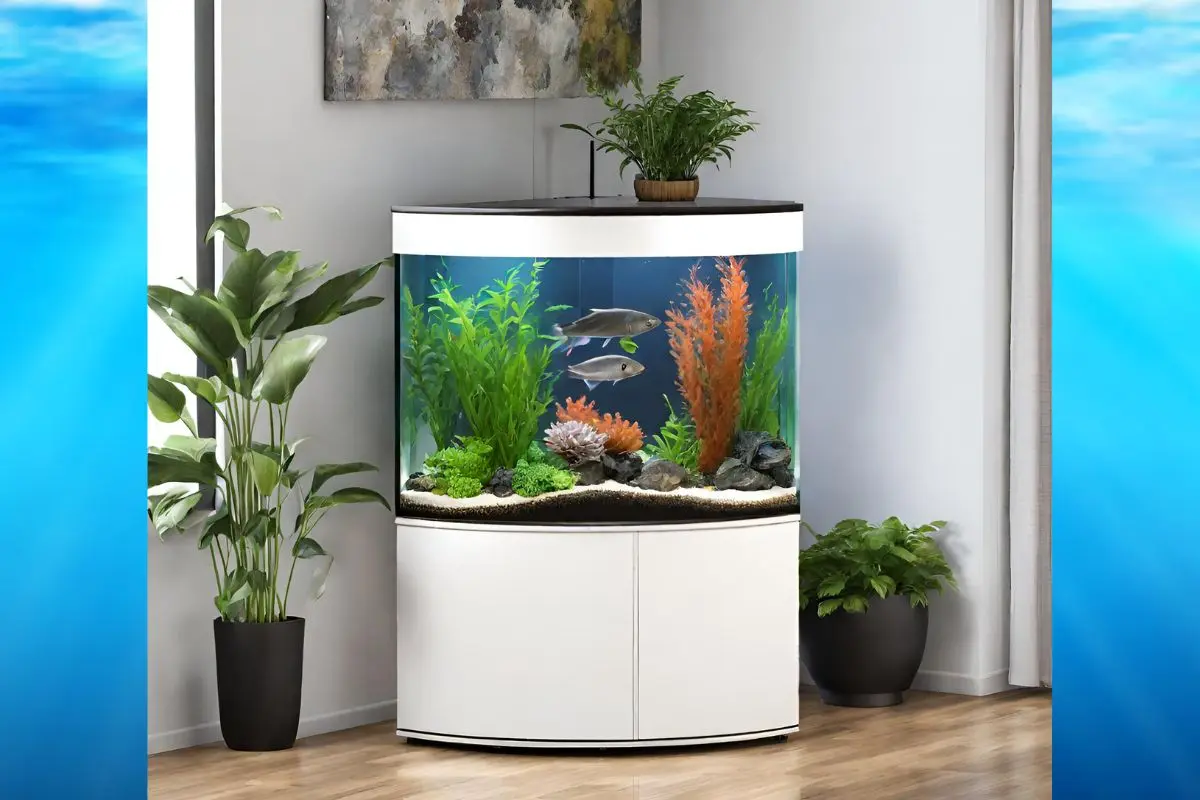
Unique Viewing Angles
The unconventional shape of corner fish tanks offers an exciting and immersive viewing experience for fish keepers. Unlike traditional rectangular tanks, which often limit viewing angles to the front and sides, corner tanks provide a panoramic perspective that allows observers to enjoy their aquatic pets from various vantage points.
Whether positioned at eye level or elevated on a stand, these tanks offer unique opportunities to observe fish behavior, explore underwater landscapes, and appreciate the intricate details of aquatic life. The curved edges of the tank create dynamic visual effects, enhancing the sense of depth and movement within the aquatic environment.
The corner placement allows for creative positioning of decor and landscaping elements, further enhancing the aesthetic appeal and visual interest of the tank.
Versatile Design Options
When it comes to design options, corner fish tanks offer a wealth of possibilities to suit diverse preferences and styles. From sleek and modern glass tanks to rustic wooden setups, there’s a wide range of materials, shapes, and finishes available to complement any decor scheme.
Whether you’re drawn to minimalist contemporary designs or prefer the timeless elegance of traditional aquariums, there’s a corner tank to match your aesthetic vision.
Additionally, accessories such as lighting fixtures, filtration systems, and substrate choices can be customized to create the perfect environment for your aquatic inhabitants.
With endless design possibilities and customization options, corner fish tanks provide a canvas for creativity and personal expression, allowing fish keepers to create truly unique and captivating aquatic displays that reflect their individual tastes and preferences.
Setting Up Your Corner Fish Tank
Now that you’re convinced of the benefits, let’s explore the essential steps to set up your corner fish tank, ensuring a successful and thriving aquatic environment for your fish:
1. Choose the Right Location
Selecting the optimal location for your corner fish tank is crucial for its long-term success. Begin by identifying a stable and level surface in the corner of your room where you intend to place the tank.
Ensure that the chosen spot can support the weight of the tank and provides easy access for maintenance tasks. Additionally, avoid placing the tank in direct sunlight, as excessive sunlight exposure can lead to algae overgrowth and fluctuations in water temperature. Instead, opt for a location with indirect natural light or artificial lighting to maintain a stable and comfortable environment for your fish.
2. Equipment and Filtration
Investing in high-quality filtration and lighting systems is essential for creating a healthy and balanced aquatic ecosystem in your corner tank. Choose filtration equipment that is appropriate for the size of your tank and the specific needs of the fish species you plan to keep.
Consider factors such as filtration capacity, water flow rate, and ease of maintenance when selecting a filter. Additionally, invest in a reliable lighting system that provides adequate illumination for both the fish and any live plants in the tank.
LED lights are a popular choice for their energy efficiency and customizable lighting options, allowing you to create the ideal environment for your aquatic inhabitants.
3. Substrate and Decor
Once you have set up the basic equipment, it’s time to add substrate and decor to your corner fish tank to create an appealing underwater landscape. Choose a substrate material that complements your desired aesthetic and provides a suitable environment for your fish and plants.
Popular substrate options include gravel, sand, and specialized aquatic soils. After adding the substrate, carefully select decorations, rocks, driftwood, and live plants to enhance the visual appeal of the tank and create naturalistic hiding spots and shelter for your fish.
Pay attention to the placement of decor to ensure that it creates a balanced and visually pleasing composition while also providing functional benefits for your aquatic inhabitants.
4. Water Parameters
Maintaining proper water parameters is essential for the health and well-being of your fish. Monitor key parameters such as temperature, pH, ammonia, nitrite, and nitrate levels regularly using test kits.
Keep a record of water test results and make adjustments as needed to ensure that the water parameters remain within the optimal range for your fish species. Regular water changes, typically ranging from 10% to 25% of the tank volume weekly or biweekly, help maintain water quality and remove accumulated waste and pollutants.
Additionally, consider investing in a quality water conditioner to remove harmful chemicals such as chlorine and chloramine from tap water before adding it to the tank.
By following these essential steps, you can set up your corner fish tank with confidence, creating a beautiful and thriving underwater habitat for your aquatic pets to enjoy. Remember to monitor water parameters regularly, perform routine maintenance tasks, and provide proper care for your fish to ensure their health and well-being in their new aquatic home.
Maintaining Your Corner Fish Tank
Proper maintenance is essential to ensure the health and longevity of your corner fish tank and its inhabitants. Here are some key tasks to incorporate into your maintenance routine:
1. Regular Cleaning
To keep your corner tank looking pristine and your fish healthy, it’s crucial to perform regular cleaning tasks. Start by conducting routine water changes to remove accumulated waste, toxins, and excess nutrients from the tank.
Aim to replace approximately 10% to 25% of the tank water every one to three weeks, depending on the stocking level and water quality. Use a siphon or aquarium vacuum to siphon debris and detritus from the substrate during water changes.
Additionally, clean the glass surfaces of your tank to remove algae buildup and maintain clear visibility. Use an algae scraper or magnetic algae cleaner to gently scrub away algae from the inside glass walls.
Be mindful not to disturb your fish or disturb the tank decor during cleaning. Regular glass cleaning not only enhances the aesthetic appeal of your tank but also promotes better light penetration and nutrient distribution for live plants.
Check your filtration system regularly to ensure it’s operating efficiently. Inspect the filter media for debris buildup and rinse or replace it as needed to maintain optimal filtration performance.
Clean the impeller and intake tube of your filter to prevent clogs and ensure proper water flow. A well-maintained filtration system helps remove waste and impurities from the water, promoting a healthy and stable aquatic environment for your fish.
2. Feeding and Care
Follow a consistent feeding schedule to meet the nutritional needs of your fish and maintain their health. Offer a varied diet consisting of high-quality commercial fish food, supplemented with occasional treats such as frozen or live foods.
Feed your fish small, frequent meals throughout the day, being careful not to overfeed, which can lead to water quality issues and health problems.
Monitor the behavior and appearance of your fish regularly to detect any signs of illness or distress. Look for abnormal behaviors such as lethargy, loss of appetite, abnormal swimming patterns, or physical abnormalities. If you notice any signs of illness, quarantine affected fish immediately to prevent the spread of disease and seek advice from a qualified aquarium veterinarian or experienced fishkeeper.
Provide appropriate care and attention to meet the specific needs of your fish species. Research the natural habitat, behavior, and dietary requirements of each species in your tank to ensure their well-being.
Consider factors such as water temperature, pH levels, and tank compatibility when selecting tank mates for your fish. Create a peaceful and harmonious environment by avoiding aggressive or incompatible fish species that may cause stress or conflict.
By incorporating these maintenance tasks into your routine, you can ensure that your corner fish tank remains clean, healthy, and thriving for years to come. Regular cleaning, proper filtration, and attentive care are essential for creating a beautiful and sustainable aquatic habitat for your fish to enjoy.
Selecting Fish for Your Corner Tank
Choosing the right fish species for your corner tank is essential for creating a harmonious and thriving aquatic community. Consider the following factors when selecting fish for your corner tank:
1. Tank Size and Space Requirements
First and foremost, consider the size of your corner tank and the space it provides for fish to swim and thrive. While corner tanks come in various sizes, it’s crucial to select fish species that are suitable for the dimensions of your tank.
Avoid overcrowding the tank, as it can lead to stress, aggression, and poor water quality. Choose fish that are compatible with the tank’s size and provide ample space for swimming and exploring.
2. Water Parameters
Take into account the specific water parameters of your corner tank, including temperature, pH, hardness, and water flow. Different fish species have varying requirements when it comes to water conditions, so it’s essential to choose fish that can thrive within the parameters of your tank. Research the natural habitat of each fish species to ensure that their requirements align with your tank’s water parameters. Maintaining stable and appropriate water conditions is crucial for the health and well-being of your fish.
3. Compatibility Among Species
When selecting fish for your corner tank, consider the compatibility among different species to avoid conflicts and aggression. Some fish species are more territorial or aggressive than others, while others are peaceful and sociable. Choose fish species that are known to coexist peacefully and exhibit compatible behaviors.
Peaceful community fish like tetras, guppies, rasboras, and small cichlids are popular choices for corner tanks due to their calm demeanor and ability to thrive in community settings.
4. Behavior and Temperament
Take into account the behavior and temperament of each fish species when selecting tank mates for your corner tank. Avoid pairing aggressive or territorial fish with shy or timid species, as this can lead to stress and conflict within the tank.
Consider the activity level, feeding habits, and social behavior of each fish species to ensure compatibility and harmony within the tank. Choose fish that exhibit similar behavior patterns and are likely to coexist peacefully in the confined space of a corner tank.
5. Dietary Needs and Feeding Habits
Consider the dietary needs and feeding habits of each fish species when planning your corner tank community. Some fish species are herbivores, while others are carnivores or omnivores, so it’s essential to provide a varied diet that meets the nutritional requirements of all fish in the tank.
Ensure that the fish you select are compatible in terms of feeding habits and dietary preferences to prevent competition for food and ensure that all fish receive adequate nutrition.
By considering these factors and researching the specific requirements of each fish species, you can create a harmonious and thriving aquatic community in your corner tank. Choose fish that are compatible with the tank’s size, water parameters, and each other’s behavior to create a peaceful and enjoyable underwater environment for both you and your fish.
Enhancing the Aesthetics with Lighting
The impact of lighting on your corner fish tank cannot be overstated—it has the power to elevate your aquarium from a simple aquatic environment to a captivating underwater display. LED lighting stands out as a top choice among aquarium enthusiasts for several reasons.
Not only is LED lighting energy-efficient, consuming less power and generating less heat compared to traditional lighting options, but it also offers a wide range of customizable color options to suit your preferences.
With LED lights, you can effortlessly create dynamic lighting effects, simulating natural daylight, moonlight, or even vibrant colors that accentuate the beauty of your aquatic landscape.
For those seeking an exceptional LED lighting solution for their corner fish tank, consider the Amazon’s Choice LED Aquarium Light. This state-of-the-art lighting fixture is designed to enhance the aesthetics of your aquarium while providing optimal lighting conditions for your aquatic plants and fish.
With its sleek and modern design, this LED light seamlessly integrates into your corner tank setup, providing uniform and controllable lighting that accentuates the colors and textures of your aquatic environment.
Whether you’re a beginner or experienced hobbyist, this LED aquarium light offers ease of use and versatility, allowing you to create stunning visual effects and transform your corner fish tank into a mesmerizing focal point in any room. Experience the beauty of your underwater world like never before with the Amazon’s Choice LED Aquarium Light.
Dealing with Common Challenges
Maintaining a corner fish tank comes with its set of challenges, but with proper care and attention, these obstacles can be overcome to ensure a thriving aquatic environment for your fish.
1. Algae Growth:
Algae growth is a common issue in aquariums, including corner tanks, and can detract from the beauty of your underwater landscape. To combat algae growth, maintain a consistent cleaning schedule by regularly scraping algae off the glass surfaces and vacuuming debris from the substrate during water changes.
Ensure proper lighting duration and intensity, as excessive light can promote algae growth. Consider introducing algae-eating fish or invertebrates, such as nerite snails or Siamese algae eaters, to help control algae naturally.
2. Water Quality Issues:
Maintaining optimal water quality is crucial for the health and well-being of your fish. Monitor water parameters regularly using test kits to ensure that levels of ammonia, nitrite, nitrate, pH, and temperature remain within the appropriate range for your fish species.
Perform regular water changes to remove accumulated waste and replenish essential nutrients. Consider incorporating live plants into your corner tank, as they can help absorb excess nutrients and improve water quality.
3. Diseases:
Fish diseases can arise due to various factors, including poor water quality, stress, and introduction of infected fish or plants. To prevent diseases, practice good hygiene and quarantine new fish and plants before introducing them to your main tank. Provide a well-balanced diet, maintain stable water parameters, and ensure proper filtration and water circulation.
If you notice any signs of illness in your fish, such as lethargy, loss of appetite, or abnormal behavior, isolate affected individuals and seek advice from a qualified aquarium veterinarian.
4. Preventing Fish Jumping:
Corner tanks often have open tops, increasing the risk of fish jumping out of the tank. To prevent this, consider investing in an aquarium cover or lid to secure the tank’s opening. Choose a cover that allows for adequate ventilation and light penetration while providing a barrier to prevent fish from escaping.
Alternatively, install a canopy or mesh netting over the tank to create a physical barrier without obstructing airflow. By implementing these measures, you can minimize the risk of fish jumping and ensure the safety of your aquatic inhabitants.
By addressing these common challenges through regular maintenance, proper care, and preventive measures, you can create a healthy and thriving environment in your corner fish tank. Stay vigilant, monitor changes in water parameters, and address issues promptly to provide the best possible care for your fish.
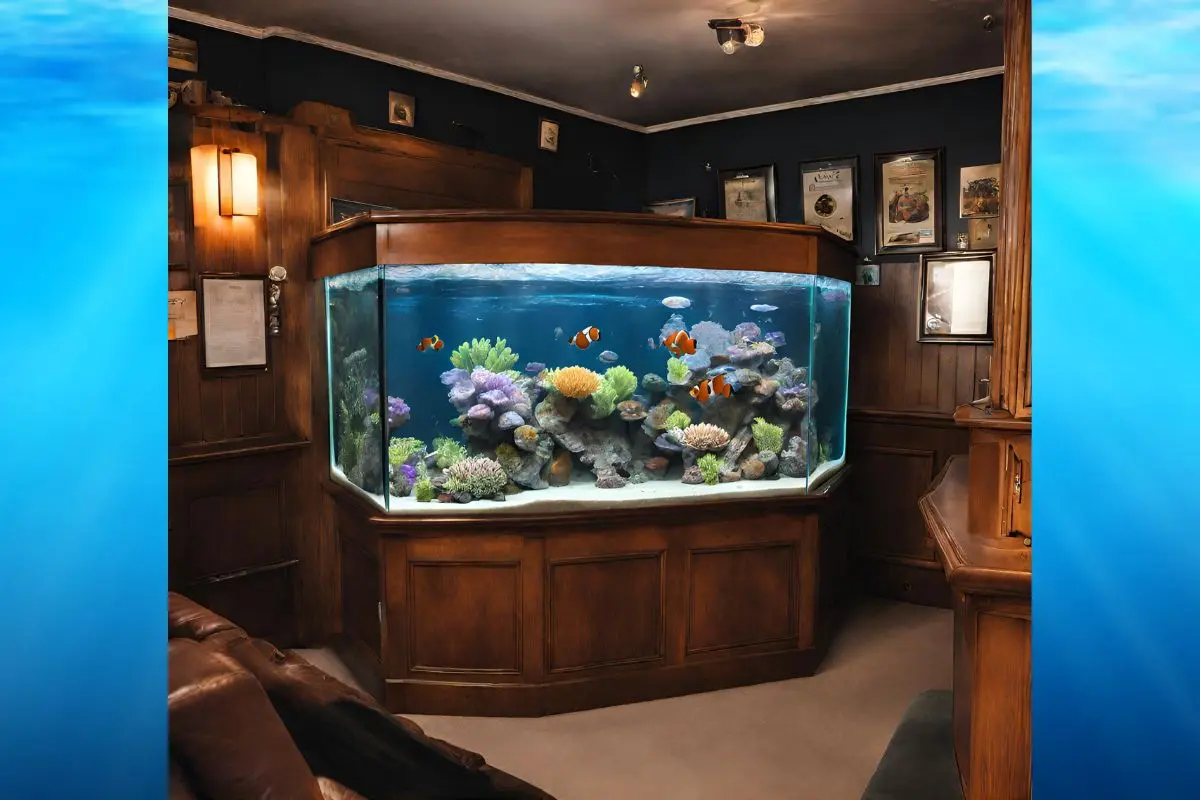
Exploring Filtration Options for Your Corner Fish Tank
Proper filtration is crucial for maintaining a healthy aquatic environment in your corner fish tank. There are various filtration options to choose from, each with its advantages and considerations.
1. Hang-On-Back (HOB) Filters
Hang-On-Back (HOB) filters stand out as a preferred filtration option for corner tanks due to their convenience and effectiveness.
These filters are favored by aquarium enthusiasts for their ease of installation and comprehensive filtration capabilities. Designed to provide mechanical, chemical, and biological filtration, HOB filters ensure that the water in your corner tank remains clean and free of impurities.
The installation process for HOB filters is straightforward, making them accessible even to beginners in the fishkeeping hobby. With simple instructions and minimal setup requirements, you can quickly attach the filter to the back of your corner tank without the need for complex plumbing or modifications.
This ease of installation makes HOB filters an attractive option for those looking to set up their corner tanks with minimal hassle.
One of the key advantages of HOB filters is their space-saving design. By hanging on the back of the tank, these filters utilize the vertical space behind the aquarium, leaving the interior of the tank unobstructed. This space-saving feature is especially beneficial in corner tanks, where every inch of space matters.
With the filter positioned outside the tank, you have more room to arrange decor, provide hiding spots for fish, and create a visually appealing underwater landscape.
Despite their compact size, HOB filters deliver efficient water circulation within the tank. The water intake located near the surface of the tank ensures effective surface skimming, removing debris and organic matter from the water’s surface.
As the water passes through the filter media, mechanical filtration removes particulate matter, while chemical filtration neutralizes harmful substances. The biological filtration stage provides a habitat for beneficial bacteria, which break down ammonia and nitrite, contributing to a stable and healthy aquatic environment.
Overall, HOB filters offer a practical and reliable filtration solution for smaller to medium-sized corner tanks. With their easy installation, comprehensive filtration capabilities, and space-saving design, these filters provide essential support for maintaining water quality and promoting the well-being of your aquatic inhabitants.
Whether you’re a novice or experienced fishkeeper, HOB filters are a valuable asset in creating a thriving underwater ecosystem in your corner tank.
2. Canister Filters
Canister filters are highly regarded in the aquarium hobby for their outstanding filtration performance and versatility. These filters are renowned for their ability to provide thorough mechanical and biological filtration, making them an excellent choice for maintaining water quality in larger corner tanks.
One of the primary advantages of canister filters is their exceptional filtration capabilities. Designed with multiple compartments and chambers, canister filters offer ample space for various types of filter media, including mechanical, biological, and chemical media.
This allows for efficient removal of debris, waste, and harmful substances from the water, resulting in a cleaner and healthier aquatic environment for fish and other inhabitants.
Canister filters are particularly well-suited for larger corner tanks due to their robust filtration capacity. With their powerful pump mechanisms and spacious filtration chambers, canister filters can effectively handle the increased volume of water in larger tanks, ensuring thorough filtration and water circulation throughout the entire tank.
Whether you have a spacious corner tank in your home or office, a canister filter provides reliable filtration performance to maintain optimal water quality.
However, it’s essential to consider the space requirements when opting for a canister filter. Unlike hang-on-back filters that hang on the back of the tank, canister filters are typically placed beneath the tank, either inside a cabinet or stand.
As such, they require additional space beneath the tank to accommodate their size and ensure proper installation. Before investing in a canister filter, carefully assess the available space in your room to ensure that there is sufficient room to install and access the filter for maintenance purposes.
Despite their space requirements, canister filters offer unparalleled filtration efficiency and versatility, making them a preferred choice for many aquarium enthusiasts.
Whether you have a large corner tank housing a diverse array of fish and plants or a biotope setup replicating a natural aquatic habitat, a canister filter provides the filtration power needed to maintain water quality and support a thriving aquatic ecosystem.
With proper installation and maintenance, a canister filter can be a valuable asset in achieving a healthy and vibrant corner tank display.
3. Sponge Filters
Sponge filters are a budget-friendly and effective choice, particularly well-suited for smaller corner tanks. These filters offer biological filtration, which is crucial for maintaining a healthy aquatic environment by fostering the growth of beneficial bacteria that break down harmful ammonia and nitrite compounds.
One of the notable advantages of sponge filters is their gentle filtration process, making them suitable for delicate fish species and fry. Unlike some other types of filters that may create strong water currents, sponge filters operate using gentle suction, ensuring that fish are not stressed by excessive water movement. This gentle filtration method also makes sponge filters ideal for breeding tanks or tanks housing small or sensitive species that may be adversely affected by strong water flow.
Sponge filters are typically placed inside the tank, where they serve as both a filtration device and a decorative element. They consist of a porous sponge material that provides a large surface area for beneficial bacteria to colonize, promoting biological filtration.
Sponge filters are powered by an air pump, which creates suction through a tube connected to the sponge. As air is drawn through the sponge, water is pulled along with it, passing through the sponge pores and becoming filtered in the process.
Another benefit of sponge filters is their simplicity and ease of use. They require minimal setup and maintenance, making them suitable for beginners and experienced hobbyists alike. Maintenance typically involves rinsing the sponge periodically to remove accumulated debris and detritus, ensuring that the filter remains effective in maintaining water quality.
Additionally, sponge filters are highly durable and can last for an extended period with proper care, making them a cost-effective filtration solution for smaller corner tanks.
Overall, sponge filters offer an affordable and efficient means of biological filtration for smaller corner tanks. Their gentle filtration process, ease of maintenance, and suitability for delicate fish species make them a popular choice among aquarium enthusiasts.
Whether you’re setting up a nano tank, a breeding tank, or a species-specific setup, a sponge filter provides reliable filtration performance and promotes a healthy aquatic environment for your fish to thrive.
4. Internal Filters
Internal filters provide a convenient and space-saving filtration solution for corner tanks, as they are designed to fit discreetly inside the aquarium. These compact filters offer both mechanical and biological filtration capabilities, effectively removing debris and harmful substances from the water while promoting the growth of beneficial bacteria.
One of the key advantages of internal filters is their compact size, which allows them to be positioned inside the corner tank without obstructing the view or detracting from the overall aesthetic. This makes them an ideal choice for aquariums where maintaining a clean and uncluttered appearance is a priority.
Additionally, internal filters are versatile and can be easily concealed behind decor or positioned in areas of the tank where they are less visible, providing flexibility in tank layout and design.
Internal filters typically consist of a filter media chamber housed within a compact housing unit. The filter media chamber contains various filtration media, such as sponge pads, ceramic rings, or bio-balls, which serve to trap debris and provide a substrate for beneficial bacteria to colonize.
As water is drawn into the filter, it passes through the filtration media, where mechanical filtration removes solid particles and biological filtration breaks down harmful ammonia and nitrite compounds.
While internal filters offer effective filtration for smaller corner tanks, they may not be as powerful as external options such as canister filters. This limitation is due to their compact size and internal placement, which may restrict the flow rate and filtration capacity compared to larger external filters.
However, internal filters are still capable of providing adequate filtration for most corner tank setups, especially those with a moderate fish load and regular maintenance routine.
Maintenance of internal filters typically involves periodic cleaning of the filter media to prevent clogging and maintain optimal filtration efficiency. Depending on the filter design, this may involve rinsing or replacing the filter media on a regular basis to remove accumulated debris and maintain water quality.
Additionally, internal filters may require occasional adjustments to ensure proper positioning and water flow within the tank.
In summary, internal filters offer a space-saving and discreet filtration solution for corner tanks, providing both mechanical and biological filtration capabilities. While they may not be as powerful as external options, internal filters are well-suited for smaller tank setups and can help maintain a clean and healthy aquatic environment for your fish. With proper maintenance and care, an internal filter can be an effective and reliable filtration choice for your corner tank.
Choosing the Right Filter
The best filter for your corner fish tank depends on several factors:
- Tank Size: Consider the size of your tank. HOB filters work well for smaller to medium-sized tanks, while canister filters are better for larger setups.
- Fish Species: Some fish produce more waste than others. If you keep a heavily stocked tank, you may need a more powerful filter.
- Space: Evaluate the available space around your tank. If you have limited space, HOB filters or internal filters may be more suitable.
- Maintenance: Consider how easy it is to maintain the filter. Some filters require more frequent cleaning and maintenance than others.
In conclusion, while each filtration option has its advantages, HOB filters are often a practical choice for corner fish tanks. They provide adequate filtration, save space, and are relatively easy to maintain. However, your specific tank requirements and preferences should ultimately guide your choice of filtration system.
Exploring Fish Options for Your Corner Tank
You can keep a wide variety of fish species in a corner tank, ranging from small freshwater fish like tetras and guppies to larger species like angelfish and dwarf cichlids.
However, it’s essential to research the specific needs of the fish you plan to keep to ensure their well-being. Consider factors such as water temperature, pH levels, tank size, and compatibility among species.
Some fish may require specific tank conditions or may not thrive in a corner tank environment due to space constraints. Always consult with knowledgeable sources or experienced fish hobbyists to determine the suitability of fish species for your corner tank setup.
Corner Fish Tanks vs. Traditional Tanks – Which is Tougher?
Corner tanks require the same level of maintenance as traditional tanks, but they may present some unique challenges due to their shape and design. The key to successful maintenance is to establish a routine and monitor water parameters regularly.
Like any aquarium, corner tanks require regular cleaning, water changes, and filter maintenance to keep the aquatic environment healthy for fish and other inhabitants. Additionally, because of their triangular or pentagonal shape, accessing and cleaning all areas of the tank may require extra care and attention.
However, with proper planning and diligence, maintaining a corner fish tank can be just as manageable as maintaining a traditional tank.
Exploring the Idea: Corner Fish Tanks in Kids’ Rooms
Corner fish tanks can be a delightful addition to a child’s room, offering both entertainment and educational value. Watching colorful fish swim gracefully in the tank can provide a calming and soothing effect, making it an excellent choice for children’s bedrooms or play areas.
Additionally, caring for fish can teach children responsibility and empathy as they learn to feed and care for their aquatic pets. However, it’s essential to ensure the tank is securely placed and safely maintained to prevent any accidents or spills. Supervision and parental guidance are recommended, especially for younger children, to ensure the well-being of both the fish and the child.
Dive into Decoration: Corner Fish Tank Inspiration!
As an experienced hobbyist in the world of fishkeeping, I can attest to the fact that creating a visually stunning corner fish tank involves more than just placing some fish in water.
It’s about crafting a captivating underwater world that not only enhances the beauty of your living space but also provides a comfortable and stimulating environment for your aquatic pets. When it comes to decorating your corner tank, there are endless possibilities to explore, each contributing to the overall ambiance and functionality of the setup.
One of the most popular decorative ideas for corner fish tanks is to start with a foundation of colorful gravel. This not only adds visual interest to the bottom of the tank but also serves as a functional substrate for live plants and beneficial bacteria. Choose gravel in shades that complement your room’s decor or opt for a contrasting color to create a striking focal point.
In addition to gravel, incorporating artificial plants into your corner tank is a fantastic way to add depth and texture to the underwater landscape. Choose plants of varying heights and leaf shapes to create a naturalistic look, and position them strategically to provide hiding spots and shelter for your fish.
Artificial plants are low-maintenance and come in a wide range of colors and styles, allowing you to customize your tank to suit your preferences.
To further enhance the aesthetic appeal of your corner tank, consider adding unique ornaments and decorations that reflect your personality and interests. From sunken shipwrecks to ancient ruins, there are endless options to choose from that can transform your tank into a themed underwater paradise.
Driftwood and rocks are also popular choices for adding a touch of natural beauty to your tank, and they provide additional surfaces for algae growth and beneficial bacteria colonization.
As you experiment with different textures, colors, and arrangements, don’t be afraid to get creative and think outside the box. Mix and match decorative elements to create visually dynamic compositions, and don’t hesitate to change things up as your tastes and preferences evolve. By infusing your corner tank with your unique style and personality, you’ll create a captivating focal point in your home that both you and your fish will enjoy for years to come.
Conclusion
In summary, a corner fish tank transcends its role as a mere aquarium; it becomes a captivating piece of art that enriches the ambiance of your home. Beyond its functionality, a corner tank offers a harmonious blend of beauty and tranquility, serving as a focal point that invites admiration and contemplation. Its space-saving design maximizes room layout possibilities, making it a practical choice for any living space, whether small or spacious.
The unique aesthetics of a corner tank elevate it to a status of elegance, enhancing the overall decor with its distinctive presence. Furthermore, the versatility it offers in terms of design options allows for personalization and creative expression, catering to the preferences of both novice and seasoned fish enthusiasts.
However, the true allure of a corner fish tank lies not only in its visual appeal but also in the thriving aquatic ecosystem it harbors within. Through diligent adherence to proper setup and maintenance practices, you can transform the corner of your room into a flourishing underwater world teeming with life.
By providing optimal conditions for your fish and other aquatic inhabitants, you can foster a healthy environment where they can thrive and flourish. Whether you’re embarking on your fishkeeping journey or seeking to enhance your existing aquatic setup, a corner fish tank offers endless possibilities for exploration and enjoyment.
Embrace the beauty and serenity it brings to your home, and let your corner tank become a source of inspiration and delight for years to come.



